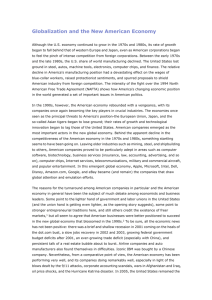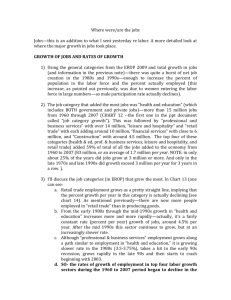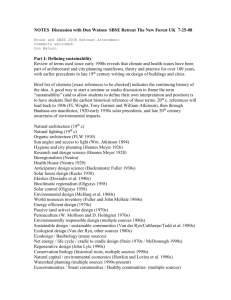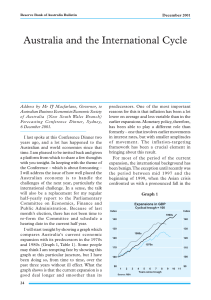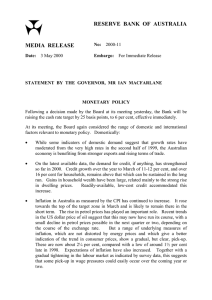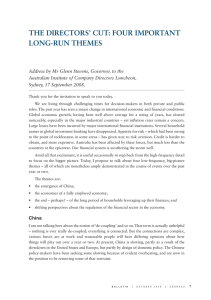Discussion 1. Steve Dowrick
advertisement
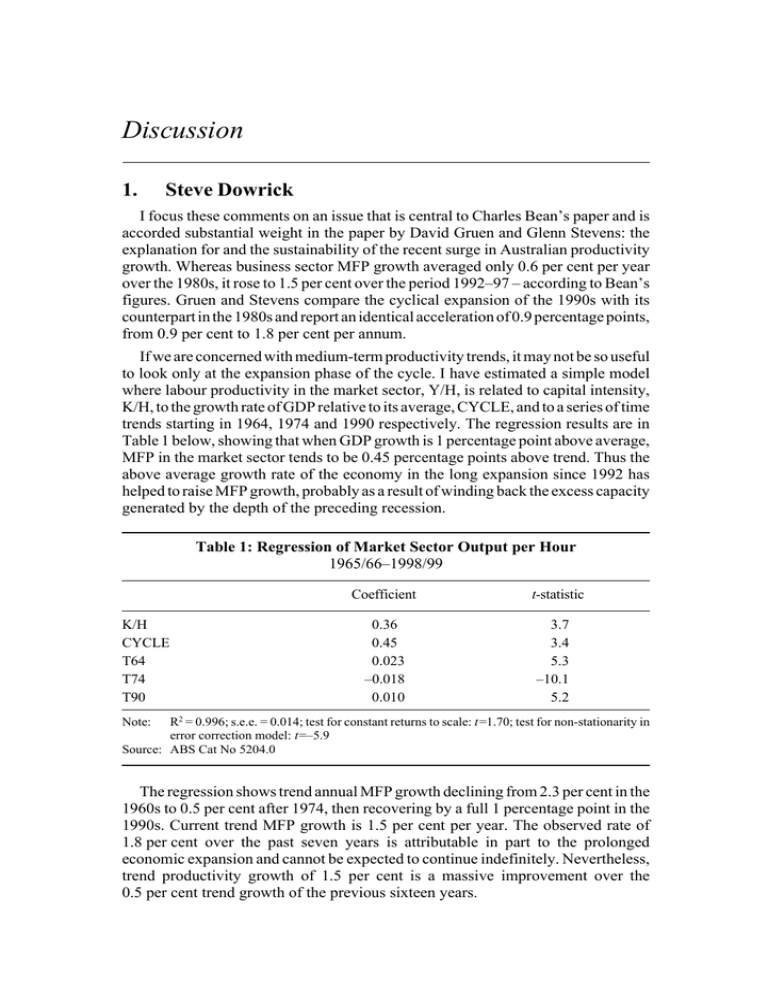
Discussion 115 Discussion 1. Steve Dowrick I focus these comments on an issue that is central to Charles Bean’s paper and is accorded substantial weight in the paper by David Gruen and Glenn Stevens: the explanation for and the sustainability of the recent surge in Australian productivity growth. Whereas business sector MFP growth averaged only 0.6 per cent per year over the 1980s, it rose to 1.5 per cent over the period 1992–97 – according to Bean’s figures. Gruen and Stevens compare the cyclical expansion of the 1990s with its counterpart in the 1980s and report an identical acceleration of 0.9 percentage points, from 0.9 per cent to 1.8 per cent per annum. If we are concerned with medium-term productivity trends, it may not be so useful to look only at the expansion phase of the cycle. I have estimated a simple model where labour productivity in the market sector, Y/H, is related to capital intensity, K/H, to the growth rate of GDP relative to its average, CYCLE, and to a series of time trends starting in 1964, 1974 and 1990 respectively. The regression results are in Table 1 below, showing that when GDP growth is 1 percentage point above average, MFP in the market sector tends to be 0.45 percentage points above trend. Thus the above average growth rate of the economy in the long expansion since 1992 has helped to raise MFP growth, probably as a result of winding back the excess capacity generated by the depth of the preceding recession. Table 1: Regression of Market Sector Output per Hour 1965/66–1998/99 Coefficient K/H CYCLE T64 T74 T90 0.36 0.45 0.023 –0.018 0.010 t-statistic 3.7 3.4 5.3 –10.1 5.2 R2 = 0.996; s.e.e. = 0.014; test for constant returns to scale: t=1.70; test for non-stationarity in error correction model: t=–5.9 Source: ABS Cat No 5204.0 Note: The regression shows trend annual MFP growth declining from 2.3 per cent in the 1960s to 0.5 per cent after 1974, then recovering by a full 1 percentage point in the 1990s. Current trend MFP growth is 1.5 per cent per year. The observed rate of 1.8 per cent over the past seven years is attributable in part to the prolonged economic expansion and cannot be expected to continue indefinitely. Nevertheless, trend productivity growth of 1.5 per cent is a massive improvement over the 0.5 per cent trend growth of the previous sixteen years. 116 Discussion Bean canvasses two broad classes of explanations for the productivity resurgence: • adoption of the new information technologies; and/or • the program of economic reforms, moving towards less regulation and more market competition in the areas of trade, labour markets and domestic product markets. He finds little evidence to support the first hypothesis in his cross-country analysis. Australian investment in Information and Computer Technology (ICT) over the last decade is barely above the OECD average. This conclusion appears to be supported by Gruen and Stevens who report that all of the rise in labour productivity since the 1980s can be attributed to just three sectors: wholesale trade, retail trade and construction – not the areas where they expect ICT to have had substantial impact on productivity. Bean identifies construction and wholesale as the sectors where productivity has accelerated most, followed by agriculture, retail and transport. The inclusion of agriculture and transport is partly due to the periods being compared, Bean comparing 1994–98 with 1988–93, whereas Gruen and Stevens are comparing over decades. More importantly, the difference is due to the different measures of productivity – Gruen and Stevens are examining labour productivity whereas Bean is looking at MFP growth, which discounts the contribution of rising capital intensity. Taking account of the relative size of sectors, my back-of-the-envelope calculations suggest that the acceleration of MFP growth in construction and in agriculture has contributed little to overall MFP growth. So the important sectors for explaining MFP acceleration are wholesale and retail. It is worth noting that finance, communications and mining have maintained high growth rates over both decades and that whilst utilities have had above average MFP growth, it has been decelerating. High productivity growth and accelerating growth are distributed across a wide range of sectors which are not, except for finance and communications, as obvious beneficiaries of the IT revolution as we might expect manufacturing to be. Perhaps, though, we should be looking more closely at the interaction between ICT investment and the skills of the labour force, where the clever use of new computer and communications technology may produce efficiency gains in planning, design and organisation across a wide range of industries. Production delays due to co-ordination problems are endemic in the construction industry. The ubiquitous adoption of mobile phones by sub-contractors in the mid 1990s may well have improved efficiency. Similar organisational efficiency gains from ICT investment may have been found in wholesale and in retail. These are sectors with a multitude of idiosyncratically interacting suppliers and customers where organisational and network externalities are likely to be large if the workforce is sufficiently skilled and adaptable, hence areas where the industry return to ICT investment is likely to exceed the perceived individual return and the difference will be reflected in MFP measures. This is similar to the argument of De Long and Summers (1991) explaining their finding of enhanced returns to investment in equipment rather than structures. If Discussion 117 correct, it suggests that it is not just the level of ICT investment that explains MFP growth, but also the level of investment in the skills of the workforce. As a matter of curiosity, in Table 2 I list the increase in adjusted MFP growth for OECD countries from the 1980s to the 1990s. Have the countries at the top of the list, including Australia, experienced both ICT and skills investment to explain their surging productivity? Table 2: Change in Adjusted MFP Growth between 1980s and 1990s Per cent 1 2 3 4 5 6 7 8 9 10 11 12 13 14 15 16 17 18 19 20 21 22 23 Note: Ireland Norway Greece Australia Portugal Denmark Iceland Netherlands Turkey Spain United States Sweden United Kingdom Finland Luxembourg Canada Italy Austria France Belgium New Zealand Switzerland Japan 2.9 2.0 1.8 1.6 1.3 1.2 0.9 0.9 0.7 0.5 0.4 0.4 0.3 0.3 0.2 0.0 –0.1 –0.1 –0.2 –0.3 –0.3 –1.0 –1.7 Derived from residuals to panel regression of OECD growth rates of GDP per capita on initial income levels, investment ratios and the growth of employment/population. Gruen and Stevens suggest in the conclusion to their paper that the primary sources of productivity growth are ‘all the difficult microeconomic reforms, and perhaps (of) the more stable macroeconomy’ – though they provide little in the way of direct evidence. John Quiggin has argued, equally plausibly, that the productivity miracle is an illusion caused by unmeasured intensification of work and unmeasured extension of working hours. 118 Discussion Bean sounds a warning that any resurgence in productivity growth attributable to micro-reform may not be sustained through the coming decade as the benefits of structural reforms, working through both trade and competitive effects, are expected to have one-off level effects. This is an important point, though I find less than compelling his ‘instructive and salutary’ comparison with the UK in the 1980s. That story seems to be mostly to do with macroeconomic mis-management – problems that were clearly relevant to the Australian economy in the late 1980s, but less relevant in the 1990s. A final salutary point comes from comparison of output gained through the productivity acceleration with output lost during the last recession. The consequences of the 1990/91 recession included a 2.5 per cent decline in GDP per capita. GDP per capita in 1992 was some 6 per cent below the level that would have been achieved if the modest average growth of the 1980s (1.8 per cent per year) had been maintained over the previous two years. The one percentage point productivity resurgence over the seven-year recovery in the 1990s has only just clawed back the output loss of the recession. Macroeconomic (mis-) management can be just as important as productivity reform in raising average living standards. Reference DeLong JB and LH Summers (1991), ‘Equipment Investment and Economic Growth’, Quarterly Journal of Economics, 106(2), pp 445–502. 2. John Edwards Gruen and Stevens provide a very interesting analysis of the 1990s which manages to capture both the issues that appeared to be important when the decade began, and the issues that now seem to us to have been important as the decade ends. The current account, for example, proved to be no impediment to growth, though at the end of the decade the deficit was quite as wide as it had been at the beginning. Low inflation and high productivity, on the other hand, were not seriously expected to be the defining characteristics our experience of the decade shows them to be. Fiscal policy has been shown (once again) to depend on the state of the cycle – as indeed it should. It is also true, as they explain, that over the decade monetary policy targeting inflation replaced wages policy as the principal means of inflation control, and that we more readily accept the argument the current account should not be a target of monetary policy or perhaps of economic policy more generally. Charles Bean’s paper by contrast takes an international view and judges Australian policy from an outsider’s perspective. He dwells on the successes of policy in the Asian crisis, during which Australian output growth actually increased while some of its major trading partners slipped into recession. He draws attention to the persistent current account deficit, and the parallels between the UK at the end of the 1980s and Australia at the end of the 1990s. I think it is quite important to ponder the Discussion 119 current account deficit, though it is also important to recognise that the blowout in the deficit at the end of the nineties was the direct result of policy adopted during the Asia crisis. And while the parallels with the UK at the end of the 1980s are troubling, Australia did of course have its own crisis at the end of the 1980s which had even closer parallels to the UK. As Gruen and Stevens declare, decades are very arbitrary periods for economic analysis. I want to argue that the contrast between the 1980s and the 1990s does not answer one of the central questions of recent economic experience, which is how we achieved low inflation. I also want to argue, however, that the contrast between the two decades does contribute more to an explanation of high productivity in the 1990s than Gruen and Stevens suggest in their paper. Finally, I want to point out that despite the contrasts there are a great many similarities between the 1980s and 1990s in the persistent impact of globalisation on the Australian economy. Gruen and Stevens are a little vague about the origins of low inflation but there is a sense in the paper, and I think more generally in Reserve Bank thinking, that inflation was very high in the 1980s, was busted by the monetary policy-induced recession of the early 1990s, and was subsequently kept low by monetary policy directed to an inflation target. The inflation figure provided in the paper (Figure 5, p 43), however, demonstrates that underlying inflation during the 1980s peaked in 1986 and thereafter fell. This is as one might expect, because we know that real wages were falling as a result of the Accord reached between the Hawke government and the Australian Council of Trade Unions. This allowed the profit share to recover in the 1980s, which may have been one of the causes of the investment boom at the end of the 1980s. But inflation was nonetheless coming down from nearly 10 per cent (underlying) in March 1986 to under 7 per cent (underlying) when the Reserve Bank began tightening monetary policy in April 1988. I think we would all agree that the recession of the early 1990s drove inflation right down, partly because business lost pricing power and partly because the currency markedly appreciated. Recessions do not necessarily produce very low inflation, however. Australia emerged from the recession of the early 1980s with inflation at 10.5 per cent, which was higher than when the recession began. Very high nominal and real wage increases continued to provide a floor. The 1980s Accord, by contrast, capped nominal wage increases in the late 1980s and early 1990s – allowing inflation to fall as demand collapsed and import prices fell. The ‘resolute pursuit in Australia of a decline in inflation’ (p 45) which Gruen and Stevens refer to was not an event only of the 1990s but also of the 1980s. The Accord with the ACTU that saw real wages falling through the 1980s was about both employment growth and lower inflation, and was relentlessly explained and defended as such. As Gruen and Stevens point out in quoting from the 1988 RBA Annual Report (p 58), the Reserve Bank itself believed the objective of the monetary tightening which began in 1988 was to reduce the growth of the current account deficit. I discovered in my own research (Edwards 1996) that this motive was also paramount with the political leadership. The magnitude of the subsequent recession was not expected (until it had already begun) and not planned, so it follows that the magnitude of the subsequent fall in inflation was not expected or intended. 120 Discussion We also know that the increasing independence of the Bank and its inflation-targeting procedure were not responsible either for the fall in inflation or the reason it remained low in the first few years of the decade. The authors date inflation-targeting to around 1993, when underlying inflation had already hit a low of around 2 per cent. Indeed, inflation-targeting was introduced then because inflation was so low. These points are not really controversial but they do add up to a slightly different way of thinking about low inflation, which we recognise as one of the centrally important outcomes of the 1990s. What they suggest is that far from being the deliberate result of a ‘Volcker disinflation’ deliberately brought about by the central bank, inflation actually crested in the mid 1980s and then began to fall in response to nominal wage restraint and falling real wages. Monetary tightening beginning in early 1988 and directed at controlling the current account deficit then produced by the beginning of the 1990s an unexpected recession and a very high currency, which sent inflation tumbling. After several years’ experience of extremely low inflation, the Bank then announced it would pursue a defined inflation target. All the tightening episode of 1988–89 had in common with the Volcker disinflation of 1979–80 was the fact that neither central bank episode intended to achieve quite the fall in activity which subsequently occurred. This slightly different way of looking at things reminds us of the importance of fortune in economic policy. It also reminds us of the costs of disinflation. Gruen and Stevens are certainly right to suggest that the decade definitively demonstrated that continuous low inflation does not preclude good output growth. But one might add that it also confirmed the output and employment costs of moving rapidly to low inflation through a recession induced by monetary policy were quite as high as widely expected. The case of inflation is one where I think a focus on the 1990s as a decade obscures an understanding of what actually happened. It suggests 1980s bad, 1990s good, when the real story it seems to me is that what happened in the 1990s was the direct result of what was begun in the 1980s. There is an instance, however, where I think a contrast between the 1980s and 1990s is quite relevant to the character of the 1990s – though Gruen and Stevens do not make much of this particular contrast. The wage determination system of the 1980s had the Industrial Relations Commission (IRC) as its centrepiece, but it was not at all similar to the wage determination system of the two earlier decades. Outside of arbitrated increases that were usually the result of earlier agreements between the government and the ACTU, there were very few claims and even fewer successful claims. Consequently there was little plant or industry-level bargaining. There were very few arbitrated increases sought or permitted for individual industries. The economy-wide arbitrated increases granted were designed to permit and succeeded in bringing about a gradual fall in real wages. While using the institutional forms of arbitration, it was in fact a radically new and quite successful way of slowing the growth of nominal wages through agreement between the government and the trade union leadership. Discussion 121 That was the system in place for around seven or eight years from 1983. Then at the end of the 1980s and the beginning of the 1990s the Hawke and Keating governments completely altered policy. The IRC was prevented from blocking enterprise agreements except in very few instances. At the same time the scope and size of arbitrated increases was confined, so that they applied only to the minority of employees receiving minimum award wages. Enterprise bargaining was not only permitted but also encouraged. This truly was a change from night to day, from a system of highly centralised wage agreements implemented nationally through the procedures of the IRC to a system of enterprise bargaining more market driven than any Australia had experienced in the twentieth century. The 1980s system favoured employment gains over productivity gains, the 1990s productivity gains over employment gains. It was also a very rapid shift. By the middle of the 1990s the proportion of employees covered by enterprise bargains was not much lower than it was at the end of the 1990s. Certainly a general wave of labour shedding at the beginning of the 1990s contributed to the acceleration of productivity growth apparent at the beginning of the upswing. But it seems to me if we are looking for the sources of Australia’s extraordinary productivity growth during the decade, and particularly why it occurred in the 1990s and not the 1980s, and why it started earlier and maintained a higher average outcome than the US, we should look first to this abrupt shift in the industrial relations framework which corresponded almost exactly to the shift between the decades. The importance of the shift from the Accord to enterprise bargaining may also offer a way of explaining the very big contribution of the services industry to productivity growth. The importance of the shift from the Accord to enterprise bargaining explains the difficulty Bean has in explaining the lower employment growth than predicted from an equation based on earlier data. Bean dates from 1996 the change in industrial relations which actually began in 1991. The transition also supports Bean’s conclusion that a full explanation of Australia’s stronger productivity performance in the 1990s cannot be found in investment in information and communications technology. Finally, a few comments about Gruen and Stevens on the current account. The presentation of net debt/GDP as the key index of the issues posed by foreign liabilities seems to me to minimise the significance of the issue. Compared to the beginning of the 1990s net debt/GDP has increased less than net liabilities/GDP, which means equity investment has increased in importance. As the authors remark, equity rewards are more dependent on the performance of the economy. But it is important to be clear that this increased equity investment is predominantly in the form of increased portfolio investment rather than direct investment. This means the current account support provided by equity investment can be and in fact is much more volatile and market sensitive than direct investment. At the same time bank debt has largely replaced corporate bond borrowing and government borrowings, and bank debt generally has a shorter maturity than the debt it replaces. In this respect Bean, while generally applauding economic management through the 1990s, raises some issues of concern. By the end of the 1990s Australia was 122 Discussion running a current account deficit around 6 per cent of GDP, and the net income deficit was around 4 per cent of GDP. Because so much of the capital inflow is portfolio or direct investment or hedged borrowing by banks, the exposure of Australian entities to the foreign exchange risk of borrowing has been minimised. The build-up of Australian liabilities offshore, however, may be the single most important reason the Australian dollar is now persistently trading well below its average value during the years since the float, well below the value suggested by ‘fair value’ models based on commodity prices, and not much higher than it was during the most alarming days of the Asian crisis. It is not a crisis, but Bean’s point that ‘at some stage in the future [some] fundamental improvement in the balance … on goods and services is [going to be] required’ is I think well taken. A general point about the two decades: there is a good deal in common between them, as well as some interesting contrasts. Through both we observe the following: rapidly increasing foreign trade compared to GDP; more rapid growth of manufacturing and service exports than either mine or farm commodity exports; a vast increase in gross capital flows in and out of Australia; growing net liabilities flowing from continuous current account deficits; minimal industrial conflict compared to previous decades; continuous deregulation and privatisation; the further elimination of subsidies; tariff cuts beginning in 1988 and continuing today; declining manufacturing employment and increasing part-time and female employment; widening income and wealth differences; quite strong growth and increasing income per head (interrupted by recession); increasing independence of the central bank (from Treasury first, then from the Government) from the 1983 float onward; income tax reform from the mid 1980s; and indirect tax reform in the mid 1990s. Most of the important trends of the 1990s were also trends of the 1980s. Most resulted from the implementation of what was called an economic rationalist agenda and the greater impact of, and interaction with, the world economy which those reforms allow. Reference Edwards J (1996), Keating: The Inside Story, Viking Penguin, New York, pp 319–394. 3. General Discussion Discussion of the papers by Gruen and Stevens and Bean centred primarily on three issues. Sources of productivity growth in Australia during the 1990s were discussed. An issue that sparked considerable debate was whether Australia’s persistent and high current account deficit was a source of vulnerability. Finally there was some discussion of the role of policy, and in particular, of monetary policy in affecting Australia’s macroeconomic performance in the last decade. The discussion of the sources of productivity growth in the 1990s overlapped considerably with the discussion of DeLong’s paper in the previous session. Discussion 123 Participants generally concurred with the view expressed in both papers that information technology had not to date been as important in generating productivity improvements in Australia as it had been in the US. They also discussed at length the effects of the structural reforms undertaken in the 1980s and the 1990s. In comparing the Australian macroeconomic environment in the two decades, a key observation was that both decades had been characterised by increased globalisation, moderate wage increases and falling inflation. The primary difference had been in the industrial-relations structure of the labour market. During the 1980s, Australia had a centrally administered system of wage determination. Some participants felt that the move toward enterprise bargaining and, therefore, a more decentralised system of wage determination, had played a key role in enhancing labour productivity, and suggested that the unemployment model developed by Bean in his paper should have allowed for this institutional change. The nature of the current account debate in the last two decades outlined in the paper by Gruen and Stevens was also reflected in this discussion. Participants acknowledged that economic outcomes over the 1990s had been more favourable than anticipated by those most concerned about the current account deficit. At the same time, some cautioned against thinking that the current account does not pose a risk, saying that the positive outcomes had resulted from the relatively favourable external environment facing the Australian economy over most of the 1990s. Citing the recent Mexican and Asian crises as examples, one participant made the point that investor sentiment is not always based on fundamentals. The participant went on to argue that while the soundness of Australia’s financial system and macroeconomic policy made a crisis of confidence very unlikely, it would be unwise to think that the current account deficit and external debt did not pose any risks at all. Though the issue of income distribution was not addressed in the two papers in this session, it was raised by a few participants. While acknowledging that macroeconomic outcomes during the 1990s had been impressive on many fronts, they felt that in the area of income distribution the outcome had been rather disappointing. One remarked that the ‘miracle’ in the Australian macroeconomy had been undermined by the widening income inequality. Another topic of discussion was the role of policy in contributing to Australia’s macroeconomic performance in the last decade. Participants felt that the underlying quality of policy as well as the institutions had been crucial, and that the adoption of the inflation-targeting framework and greater central bank independence, in particular, had enhanced the credibility of monetary policy. One suggested that the paper by Gruen and Stevens should have conducted a more structured and quantitative analysis of the effect of monetary policy on the economic outcomes observed in the 1990s. One participant remarked that the policy challenge for the next decade was to avoid a severe recession. This participant argued that, provided any economic downturn could be kept moderate, prospects for macroeconomic performance remained positive.
